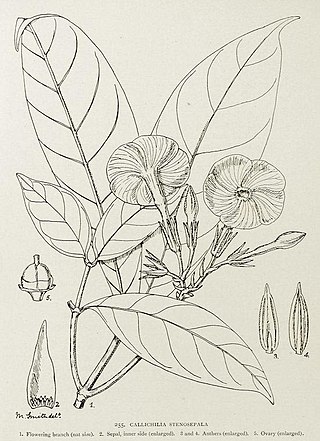
Panda is a plant genus of the family Pandaceae. It contains only one known species, Panda oleosa, native to western and central Africa.
Crotonogyne is a shrub of the spurge family (Euphorbiaceae) first described as a genus in 1864. It is native to western and central Africa. It is dioecious.
Dichostemma is a flowering plant genus in the family Euphorbiaceae first described as a genus in 1896. It is native to tropical western and central Africa.
- Dichostemma glaucescensPierre - Nigeria, Cameroon, Gabon, Republic of the Congo, Central African Republic, Cabinda, Democratic Republic of the Congo
- Dichostemma zenkeriPax - Cameroon
Plagiostyles is a plant genus in the family Euphorbiaceae first described as a genus in 1897. It is native to tropical Africa.
- Plagiostyles africana(Müll.Arg.) Prain - Nigeria, Cameroon, Gabon, Cabinda Province, Angola, Equatorial Guinea, Republic of the Congo, Democratic Republic of the Congo
- Plagiostyles pinnatusWilld. - Gabon

Synsepalum is a genus of trees and shrubs in the chicle family, Sapotaceae described as a genus in 1852.

Autranella is a genus of plant in family Sapotaceae described as a genus in 1917. It contains only one recognized species, Autranella congolensis, native to west-central Africa.
Calochone is a genus of flowering plants in the family Rubiaceae. The genus is found in Cameroon, Gabon, Cabinda Province, Republic of the Congo, and Democratic Republic of the Congo.
Eremospatha is a genus of climbing flowering plants in the palm family found in tropical Africa. These rattans are uncommon in cultivation and poorly understood by taxonomists. Closely related to Laccosperma, they are differentiated by the near complete absence of bracts and bracteoles. The name is from Greek meaning "without a spathe".
Guaduella is a genus of African plants in the grass family, the only genus in the tribe Guaduelleae. It belongs to the subfamily Puelioideae, one of the early-diverging lineages in the grasses, but used to be included in the bamboos.
- Guaduella densifloraPilg. - Nigeria, Cabinda, Cameroon, Republic of Congo, Gabon, Equatorial Guinea
- Guaduella dichroaCope - Cabinda
- Guaduella humilisClayton - Nigeria, Cameroon
- Guaduella macrostachys(K.Schum.) Pilg. - Ghana, Nigeria, Cameroon, Gabon
- Guaduella marantifoliaFranch. - Cameroon, Republic of Congo, Gabon
- Guaduella oblongaHutch. ex Clayton - Guinea, Sierra Leone, Ivory Coast, Cameroon, Republic of Congo, Gabon, São Tomé, Bioko
Cuviera is a genus of flowering plants in the family Rubiaceae native to tropical Africa. It was originally described by Augustin Pyramus de Candolle in 1807 and is named after the French naturalist Georges Cuvier.
Atractogyne is a genus of flowering plants in the family Rubiaceae. It is found in western and western-central tropical Africa.
Aulacocalyx is a genus of flowering plants in the family Rubiaceae. It is found in tropical Africa.

Craterispermum is a genus of flowering plants in the family Rubiaceae. It contains 16 species that occur in tropical Africa and Seychelles. It is the only genus in the tribe Craterispermeae, of which the divergence time is estimated at 34.8 million years ago.
Adenorandia is a monotypic genus of flowering plants in the family Rubiaceae. It was described by Vermoesen in 1922. The genus contains only one species, viz. Adenorandia kalbreyeri, which is found from west-central tropical Africa.

Callichilia is a genus of plant in the family Apocynaceae, native to tropical Africa.

Pleiocarpa is a genus of plant in the family Apocynaceae first described as a genus in 1876. It is native to tropical Africa from Senegal to Tanzania and south to Zimbabwe. As of August 2013 the World Checklist of Selected Plant Families recognises 6 species:
- Pleiocarpa bicarpellataStapf - Cabinda, Cameroon, Republic of the Congo, Gabon, Democratic Republic of the Congo, Kenya
- Pleiocarpa brevistylaOmino - Gabon
- Pleiocarpa muticaBenth. - Ghana, Ivory Coast, Liberia, Sierra Leone, Nigeria, Cameroon, Gabon, Central African Republic, Republic of the Congo
- Pleiocarpa picralimoides(Pichon) Omino - Cabinda, Republic of the Congo, Gabon
- Pleiocarpa pycnantha(K.Schum) Stapf - widespread across most of tropical Africa
- Pleiocarpa rostrataBenth. - Nigeria, Cameroon, Gabon
- Pleiocarpa camerunensis(K.Schum. ex Hallier f.) Stapf = Hunteria camerunensisK.Schum. ex Hallier f.
- Pleiocarpa hockiiDe Wild. - Acokanthera oppositifolia(Lam.) Codd
- Pleiocarpa simii(Stapf) Stapf ex Hutch. & Dalziel = Hunteria simii(Stapf) H.Huber

Englerophytum is a group of trees in the family Sapotaceae described as a genus in 1914.
Preussiodora is a genus of plants in the family Rubiaceae. It contains only one species, Preussiodora sulphurea, native to central Africa.
Colletoecema is a genus of flowering plants in the family Rubiaceae. It is the only genus in the tribe Colletoecemateae. The 3 species are found from west-central tropical Africa to Angola.
Orthopichonia is a genus of plants in the family Apocynaceae, first described as a genus in 1953. It was initially given the name Orthandra, but this turned out to be an illegitimate homonym. Orthopichonia is native to Africa.






